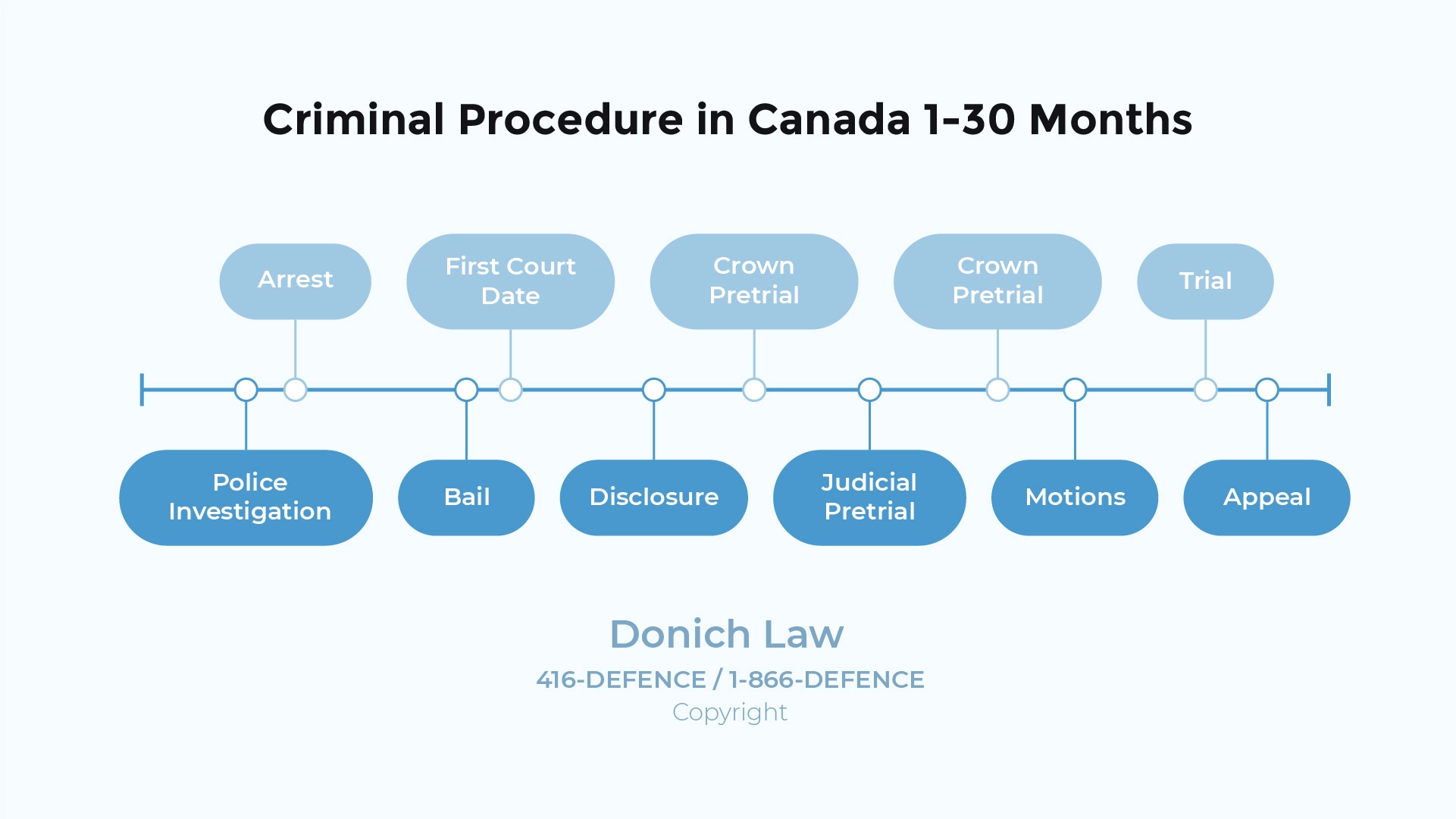
First Offenders in Canada
Being charged with a criminal offence for the first time can be a stressful and upsetting experience. When an individual is charged with a criminal offence for the first time, their first-time offender status will often impact the way their case makes its way through the criminal justice system. When an individual is initially arrested for an offence, whether or not they have a prior criminal history may influence whether they are released by the police or held for a bail hearing. When the criminal case file is sent to the Crown’s office, the accused’s first offender status may impact the way the Crown initially screens the case. Finally, if the accused individual is ultimately convicted of the offence, their first offender status will be a mitigating factor and may lead to a reduced sentence.
How Does First Offender Status Affect the Prosecution of a Case?
A person’s status as a first offender impacts how the Crown prosecutes their case from the very beginning of the criminal justice process. After the offender has been arrested and charged with an offence by the police, they pass all the information about the offender and the evidence of the offence they were able to collect to the Crown. Once the Crown has possession of that information, they begin a two-stage process that is required to comply with the offender’s right to receive disclosure about the case being made against them. The first stage of that process, known as screening, is where a first offender’s status comes into play.
While conducting screening, the Crown is deciding on their prosecution strategy for a particular case. This involves evaluating all available information about an offender, including their previous criminal record, as well as the circumstances of the offence they committed. This information is considered by the Crown, and they then produce a sentencing proposal that they feel would be appropriate if the offender were to plead guilty to the offence at that moment in time. This information is provided to the accused in what is known as an Adult Charge Screening Form. The Adult Charge Screening Form

- CP24: Civil Sexual Assault Lawsuit at St. Michael’s in Toronto.
- Global News Morning Show: Sentencing Arguments in Assault case of Dafonte Miller.
- Breakfast Television: Role of Mental Health in Court Proceedings.
- Global News National: Bruce McArthur will not serve consecutive sentences.
- CBC Radio: Interview with Mayor John Tory and Jordan Donich on CBC Radio.
- CTV News National: Handgun ban supported by majority of Canadians: Nanos survey.
- Global News: How difficult is it to get a legal handgun in Canada.
- CP24: Sentencing Hearing for Chair Girl.


How Does First Offender Status Affect Sentencing?
Just as a person’s first offender status affects how they will be prosecuted; it also impacts how they will be sentenced if they are convicted of an offence. Sentencing in Canada is governed by several principles that are fundamental to the beliefs of our society. They are found under s. 718 of the Criminal Code. The purpose of sentencing is to protect society and to maintain order among the people. Sentences achieve this because they are built around main objectives such as denouncing the unlawful conduct and harm to any victims done by offenders, deterring others from committing crimes, separating offenders from society where necessary, and assisting in rehabilitating offenders and aiding them in becoming contributing members of society. This last factor is often the most relevant to first time offenders.
In most cases, a person who has committed their first offence stands the best chance of rehabilitation because they do not have a history of criminal behaviour. Typically, first time offenders will receive more lenient sentences because there is no prior criminal record to suggest a pattern of criminality.
An offender’s age is often considered alongside their status as a first offender. For example, if a person is older when they were convicted of their first offence, a court will recognize that they have followed the law for their entire life and likely will follow it again after their case has been resolved. Therefore, a strong sentence is not necessary. Similarly, if a person is younger when they commit an offence, even a young offender, courts are less likely to issue strict sentences. In these instances, the court may be more inclined to believe the incident was a youthful indiscretion. The court’s sentence would then be focused on rehabilitation and ensuring the offender does not repeat the behaviour in the future.
Stages of the Criminal Justice System

What are Aggravating and Mitigating Factors?
Aggravating and mitigating factors are facts that a court takes into consideration when they are deciding on the specific sentence that an offender should receive. They are bits of context about an offender and the offence that was committed. When these factors are taken together with the fundamental principles of sentencing discussed in the previous question, it leads a to a conclusion on the proper sentence for each case. Aggravating and mitigating factors exist in every case and must be appropriately balanced by the court.
Aggravating factors are facts that increase the moral blameworthiness of the offender and therefore increase the sentence an offender might receive. The Code sets out several aggravating factors, but the facts of each case will determine which ones apply in each circumstance. Common aggravating factors include: the number of victims of the crime and the number of times it was committed; if the crime was motivated by hate, prejudice, or bias on racial, sexual or other grounds; whether the offence was violent in nature and the severity of that violence, if the victims of the crime included the offender’s family or someone under the age of 18; or if the offender committed the crime in the course of their job.
Mitigating factors are the opposite of aggravating factors. They are facts that reduce an offender’s moral blameworthiness and therefore the sentence they might receive. First offender status is a powerful mitigating factor, as is the age of the offender in some cases. Other mitigating factors include whether an offender has pled guilty to an offence and accepted responsibility for their actions, whether they have demonstrated insight into their behaviour, or if they successfully complied with any bail conditions that were imposed on them before their case was resolved.
What’s a Crime in Canada?
Can a First Time Offender Go to Jail?
It is possible for a first offender to be sentenced to a period of imprisonment in some cases. No one aggravating or mitigating factor is strong enough to determine the appropriate sentence on its own. One of the most important principles of sentencing under Canadian law is referred to as proportionality. Proportionality means offenders should receive sentences that reflect the gravity of the offence they committed. This means that the more serious an offence is, the stricter an offender’s sentence will be. For example, if a person commits a violent offence such as certain sexual assaults or homicides, imprisonment will likely be the only appropriate sentence. In those cases, first offender status can only act in the offender’s favour by possibly reducing the amount of time the offender must remain in prison. Further, some offences in the Code carry mandatory minimum sentences, regardless of whether the offender has a criminal record.
Law Newbie is a free AI research assistant that can help you safely answer questions about criminal law.




Recent Cases
R. v. Andrews, 2023 ONCJ 370
This Ontario Court of Justice case is an example of how first offender status acts as one factor that can lead to a lesser sentence. Here, the offender and her acquaintance were charged with assault after a physical altercation at a baseball game. The offender and her friend were seated behind the victim and the two parties got into a drunken argument. As the argument escalated, the offender grabbed the victim’s hair, pulled her up and began punching her in the head. The victim was not seriously injured by this assault but was injured by further actions taken by the other accused.
The offender was issued a conditional discharge with one year of probation. The sentence is not considered a conviction, as it would disappear from the offender’s record if she successfully complied with all the conditions the court imposed. The reasoning for the sentence sought to balance the applicable first offender status and other personal factors with the deterrence that is necessary when a violent act has been committed.
In its decision, the Court stated that “[a]chieving a fit sentence necessitates the balance of competing objectives. For example, sentencing a first offender is primarily guided by individual deterrence and rehabilitation. But when their offence is violent, denunciation and general deterrence must gain prominence in the analysis. I found that general deterrence and denunciation must be expressed in the sentence imposed upon Ms. Andrews. The repeated nature of the punches, the public forum in which the assault was committed, and the dissemination of the assault on the internet express this need quite clearly. But in my view, these objectives should not overwhelm my analysis either. This is a relatively youthful first offender who committed her offence during a mental health crisis. She is of indigenous heritage, with a fractured and tumultuous upbringing. It is imperative that this sentence achieve the goals of rehabilitation and specific deterrence.” [at paras 33-35]
This quote demonstrates the weight that first offender status can have on sentencing decisions. While that status does not absolve the offender of responsibility for their actions, it shows that they should not be subject to a harsh sentence for one infraction. Overly strict punishments would limit the rehabilitative purpose of sentences and offenders should be given the opportunity to improve themselves where that improvement can be done without extreme judicial intervention.
R. v. I.C., 2024 ONSC 1406
This Ontario Superior Court of Justice case is an example of when an offender’s first offender status is outweighed by the seriousness of the offence they committed. Here, the offender was convicted of sexual interference that victimized his stepdaughter when she was between the ages of 11-13. The offence involved the offender pulling the victim onto his lap while he was laying in bed and bouncing her up and down while his penis became erect. He did not stop until the victim insisted several times.
The offender was sentenced to 10 months imprisonment. He was also issued several additional, or ancillary, orders that included a DNA order, a 10-year weapons ban, a SOIRA order, and a 10-year ban restricting access to children. Regarding first offender status, the court identified that for crimes involving sexual violence, the sentencing principles of denunciation and deterrence become more important even where the offender has no previous criminal history. The Court stated that “I accept however that sexual violence against children is inherently wrong, regardless of the degree of physical interference and that I must also focus on the wrongfulness and harmfulness of sexual offences against children. Even one instance as in this case can have a serious impact on a complainant as was the case here.” [at para 47] This quote shows the dominant factor in this case. Though the court did highlight the fact that the offender was a 45-year-old man with no prior criminal record, that only mitigated the length of the final sentence.











